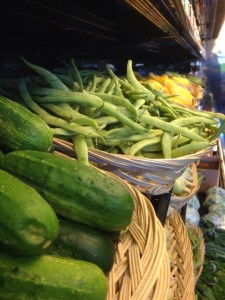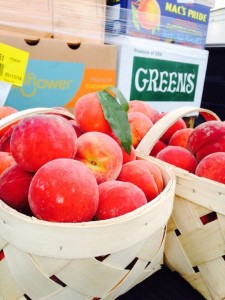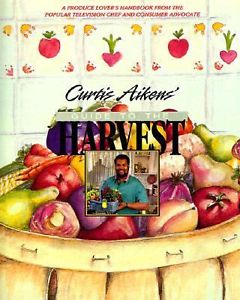These keys should guide you through an produce section, helping you choose the freshest sweetest fruits and vegetables available. One and more of these keys will always come into play in selecting fresh fruits or vegetables.

notice the damage on this cucumber don’t buy that!
(1) LOOK. Always look at your fresh fruit or vegetable to be sure it has good color. However, color is not always a true indication of ripeness. The main things to look for are bruises or scars. If either is present, disregard that item and choose one free from damage. Why? Let’s face it: pesticides and other chemicals are with us to stay, and in most instances, they are applied to the outside of produce. Although they can’t be washed away, they can be peeled away, but if scars or bruises are present, that pesticide on the outside may seep into the flesh of your fresh fruit item. So remember,
avoid damaged produce.
(2) SMELL. Don’t be afraid to follow your nose. Here is something I will never forget. Once while shopping in New York’ Hunt’s Point Market, two so-called produce experts laughed at me for smelling tomatoes. I not only got upset, I got mad. I pointed out to those guys that the boxes I did not select were bad. If they would smell they could tell. I also pointed out to the “experts” that as tomatoes ripen, they do give off a rather strong tomato aroma. Which brings another good saying about fruits: If it smells peachy, it’s going to taste peachy. Remember, as fruit ripens, not only does the sugar level rise, but also the fragrance becomes much stronger and more fruity. As for vegetables, when they pass their peak, they usually give off a slightly sour smell.

if it don’t smell peachy it wont taste Peachy
(3) TOUCH. No buyer or fresh fruit wants items that are either rock hard or marshmallow soft. Most fruit, when ripe, gives just a little to slight pressure. Remember that it’s okay to pick up produce and inspect it before buying, but please do not squeeze the life out of items, especially ones that you are not going to purchase. A piece of fruit that was too hard or too soft for your liking may be just perfect for someone else. Vegetables,
be they broccoli, cabbage, carrots, or whatever, should always be firm. Never buy limp vegetables.
(4) SEASON. Know the season of fresh fruits and vegetables and buy what is in season. You will learn the seasons while reading this book; the buying part becomes more difficult due to ever increasing, shipments of fresh fruits and vegetables from the southern hemisphere, where the seasons are the opposite of ours. Before buying an item from a region with a reverse season, first see what that region has to offer. One easy way to tell what is in season, is to take a moment to look around your greengrocer’s store or the produce section of your supermarket and see which items are in the greatest abundance. I guess I should add a fifth key: get to know your greengrocer, who should be able to tell you anything there is to know about the produce in his or her shop. A further note: Although fresh fruits and vegetables will often keep a week in the refrigerator, it is best to use them within three days of purchasing. And in most cases, storing them in paper bags is preferable to storing in plastic ones.



